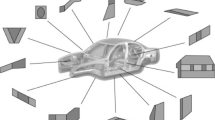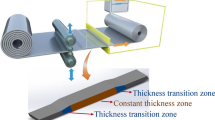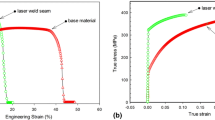Abstract
In recent years, significant attention has been garnered by Tailor Rolled Blanks (TRBs), especially within the automotive industry, attributed to their unique performance characteristics, defined by varying thickness profiles. Nonetheless, the inherent structural complexities of TRBs have led to non-uniform deformation during forming processes, thereby compromising elongation and formability. In this study, an exploration into the deformation of TRBs under uniaxial tensile conditions is elucidated, centering specifically on TRBs transitioning from a thickness of 1–2 mm over a 100 mm span. An assessment of the properties of TRBs following partial annealing is conducted, and mechanisms responsible for thickness variations and the revelation of intrinsic mechanical traits are identified through microstructural examinations. Exploration of the mechanical behavior of TRBs under tension is undertaken, and a methodological approach for optimizing the distribution of mechanical properties is proposed. Validation is achieved through the employment of finite element models, showcasing a performance improvement in the optimized TRBs, with uniform elongation rates surpassing those of non-optimized TRBs by up to 197%. Moreover, an outperformance of uniform-thickness materials by up to 51% is exhibited by the optimized TRBs. These insights are anticipated to bolster the application and efficiency of TRBs across various engineering sectors, aligning coherently with the intelligent design and advanced materials implications within the realm of mechanics and materials in design, as spotlighted by "The International Journal of Mechanics and Materials in Design". This exploration intricately intertwines mechanics, material engineering, and intelligent design, offering a comprehensive view that stands to fortify the symbiotic relationship between advanced materials and the design process.

























Similar content being viewed by others
Data availability
Data will be made available on request.
References
Asnafi, N., Andersson, R., Persson, M., Liljengren, M.: Tailored boron steel sheet component properties by selective laser heat treatment. IDDRG 2016 Conf. 159, 1–14 (2016). https://doi.org/10.1088/1757-899X/159/1/012023
Audoly, B., Hutchinson, J.W.: Analysis of necking based on a one-dimensional model. J. Mech. Phys. Solids 97, 68–91 (2016). https://doi.org/10.1016/j.jmps.2015.12.018
Bondarenko, S., Stolbchenko, M., Schaper, M., Grydin, O.: Numerical analysis of twin-roll casting of strips with profiled cross-section. Mater. Res.-Ibero-Am. J. 21, e20171098 (2018). https://doi.org/10.1590/1980-5373-MR-2017-1098
Considère, M.: Mémoire sur l’emploi du fer et de l’acier dans les constructions. Annales Des Ponts Et Chaussées 9, 574 (1885)
Du, P., Hu, X.-L., Wang, J., Liu, X.-H.: Multiple-point dynamic setting for variable cross-section rolling process. J Iron Steel Res 21, 27–30 (2009). https://doi.org/10.13228/j.boyuan.issn1001-0963.2009.11.004
Engler, O., Schafer, C., Brinkman, H.J., Brecht, J., Beiter, P., Nijhof, K.: Flexible rolling of aluminium alloy sheet-process optimization and control of materials properties. J. Manuf. Process. Tech. 229, 139–148 (2016). https://doi.org/10.1016/j.jmatprotec.2015.09.010
Field, N.N., Di Ciano, M., Duan, K.J.: Tailoring by direct contact heating during hot forming/die quenching. Metall. Mater. Trans. A 50A, 3705–3713 (2018). https://doi.org/10.1007/s11661-019-05283-0
George, R., Bardelcik, A., Worswick, M.J.: Hot forming of boron steels using heated and cooled tooling for tailored properties. J. Manuf. Process. Tech. 212, 2386–2399 (2012). https://doi.org/10.1016/j.jmatprotec.2012.06.028
Ghosh, A.K.: Tensile instability and necking in materials with strain hardening and strain-rate hardening. Acta Metall. Metall. 25, 1413–1424 (1977). https://doi.org/10.1016/0001-6160(77)90072-4
Graser, M., Wiesenmayer, S., Muller, M., Merklein, M.: Application of tailor heat treated blanks technology in a joining by forming process. J. Manuf. Process. Tech. 264, 259–272 (2019). https://doi.org/10.1016/j.jmatprotec.2018.09.006
Guo, Y., Xu, P.-W., Yu, L.: A longitudinal gradient architecture achieves better tensile properties in Ti6242 alloy. J. Mater. Res. Technol. 24, 8002–8013 (2023). https://doi.org/10.1016/j.jmrt.2023.05.072
Han, S.-W., Hwang, T.-W., Oh, I., Choi, M., Moon, Y.-H.: Manufacturing of tailor-rolled blanks with thickness variations in both the longitudinal and latitudinal directions. J. Manuf. Process. Tech. 256, 172–182 (2018). https://doi.org/10.1016/j.jmatprotec.2018.02.013
Hart, E.W.: Theory of the tensile test. Acta Metall. Metall. 15, 351–355 (1967). https://doi.org/10.1016/0001-6160(67)90211-8
Hauger, A., Muhr, T., Kopp, R.: Flexible rolling of tailor rolled blanks. Stahl EisenEisen. 126, 21–23 (2006)
Hill, R.: On discontinuous plastic states with special reference to localized necking in thin sheets. J. Mech. Phys. Solids 1, 19–31 (1952). https://doi.org/10.1016/0022-5096(52)90003-3
Hirt, G., Bambach, M., Lohmar, J., Guvenc, O., Henke, T., Schwich, G.: Materials modelling in industrial bulk metal forming processes and process chains. Comput. Meth. Mater. Sci. 15, 5–12 (2015)
Hu, X.-L., Ke, D.-W., Zhi, Y., Liu, X.-H.: Effect of two steps overaging on mechanical properties of tailor rolled blank of dual phase steel. Metals Basel 11, 1–14 (2021). https://doi.org/10.3390/met11050792
Huo, M.-S., Zhao, J.-W., Xie, H.-B., Li, S.-L., Zhang, H.-M., Hu, Z.-P., Jiang, Z.-Y.: Microstructure and mechanical properties of thin varying thickness strips with different transition zones produced by micro flexible rolling. P. I Mech. Eng. B-J. Eng. 233, 1954–1967 (2019a). https://doi.org/10.1177/0954405418802323
Huo, M.-S., Zhao, J.-W., Xie, H.-B., Jia, F.-H., Li, S.-L., Zhang, H.-M., Jiang, Z.-Y.: Effects of micro flexible rolling and annealing on microstructure, microhardness and texture of aluminium alloy. Mater CharactCharact. 148, 142–155 (2019b). https://doi.org/10.1016/j.matchar.2018.12.007
Jouve, D.: Analytic study of plastic necking instabilities during plane tension tests. Eur. J. Mech. A-Solids 39, 180–196 (2013). https://doi.org/10.1016/j.euromechsol.2012.09.008
Ke, D.-W., Liu, X.-H., Zhi, Y., Hu, X.-L., Liu, L.-Z.: Experiment on properties differentiation in tailor rolled blank of dual phase steel. Mat. Sci. Eng. A Struct. 742, 629–635 (2019). https://doi.org/10.1016/j.msea.2018.11.041
Keeler, S.P., Backofen, W.A.: Plastic instability and fracture in sheets stretched over rigid punches. Trans. ASM 56, 25–48 (1961)
Kim, J.-H., Ko, D.-C., Lee, S.-B., Kim, B.-M.: Hardness prediction in hot stamping process by local blank heating based on quench factor analysis. Metals Basel 9, 1–14 (2018). https://doi.org/10.3390/met9010029
Kopp, R.: Some current development trends in metal-forming technology. J. Manuf. Process. Tech. 60, 1–9 (1996). https://doi.org/10.1016/0924-0136(96)02301-1
Li, M., Richmond, O.: Intrinsic instability and nonuniformity of plastic deformation. Int. J. Plasticity 13, 765–784 (1997). https://doi.org/10.1016/S0749-6419(97)00032-6
Liu, H.-S., Lei, C.-X.: Local heating-aided hot blanking of quenched ultra-high-strength steel BR1500HS. Int. J. Adv. Manuf. Tech. 77, 629–641 (2015). https://doi.org/10.1007/s00170-014-6479-y
Liu, X.-H., Gao, Q., Su, C., Hu, X.-L., Zhi, Y.: New process of theory and application in variable gauge rolling. Steel Roll 29, 1–7 (2012). https://doi.org/10.13228/j.boyuan.issn1003-9996.2012.03.005
Long, S.-L., Yi, Y.-L., Gui, Q., Long, X., Su, M.-H., Liang, Y.-L.: A novel model to predict microvoid evolution in tensile necking using macroscopic deformation behavior. J. Mater. Res. Technol. 25, 2040–2048 (2023). https://doi.org/10.1016/j.jmrt.2023.06.072
Lu, R.-H., Liu, X.-H., Chen, S.-D., Xu, Z.-G., Hu, X.-L., Liu, L.-Z.: Theoretical investigation on the crushing performances of tailor rolled tubes with continuously varying thickness and material properties. Int. J. Mech. Sci. 151, 106–117 (2019). https://doi.org/10.1016/j.ijmecsci.2018.09.012
Markandan, K., Lim, R.-J., Kanaujia, P.K., Seetoh, I., Rosdi, M.R.B.M., Tey, Z.H., Goh, J.S., Lam, Y.C., Lai, C.-Q.: Additive manufacturing of composite materials and functionally graded structures using selective heat melting technique. J. Manuf. Sci. Tech. 47, 243–252 (2020). https://doi.org/10.1016/j.jmst.2019.12.016
McBrien, M., Allwood, J.M., Barekar, N.S.: Tailor blank casting-control of sheet width using an electromagnetic edge dam in aluminium twin roll casting. J. Manuf. Process. Tech. 224, 60–72 (2015). https://doi.org/10.1016/j.jmatprotec.2015.03.034
Nakagawa, Y., Mori, K., Suzuki, Y., Shimizu, Y.: Tailored tempering without die heating in hot stamping of ultra-high strength steel parts. Mater. Design 192, 1–17 (2020). https://doi.org/10.1016/j.matdes.2020.108704
Oliferuk, W., Maj, M.: Plastic instability criterion based on energy conversion. Mat. Sci. Eng. A Struct. 462, 363–366 (2007). https://doi.org/10.1016/j.msea.2006.02.465
Rabczuk, T., Ren, H.-L., Zhuang, X.-Y.: A nonlocal operator method for partial differential equations with application to electromagnetic waveguide problem. CMC-Comput. Mater. Con. 59, 31–35 (2019). https://doi.org/10.32604/cmc.2019.04567
Raghavan, K.S., Garrison, W.M.: An investigation of the relative effects of thickness and strength on the formability of steel sheet. Mat. Sci. Eng. A Struct. 527, 5565–5574 (2010). https://doi.org/10.1016/j.msea.2010.05.004
Ren, H.-L., Zhuang, X.-Y., Rabczuk, T.: Dual-horizon peridynamics: a stable solution to varying horizons. Comput. Method. Appl. M 318, 762–782 (2017a). https://doi.org/10.1016/j.cma.2016.12.031
Ren, H.-L., Zhuang, X.-Y., Anitescu, C., Rabczuk, T.: An explicit phase field method for brittle dynamic fracture. Comput. Struct.. Struct. 217, 45–56 (2017b). https://doi.org/10.1016/j.compstruc.2019.03.005
Ren, H.-L., Zhuang, X.-Y., Oterkus, E., Zhu, H.-H., Rabczuk, T.: Gradient elasticity, magneto-electro-elasticity and phase-field fracture by nonlocal operator method. Enh Comput.-Germany 39, 23–44 (2023). https://doi.org/10.1007/s00366-021-01502-8
Shafiei, E., Dehghani, K.: Tensile behavior of tailor rolled blanks with longitudinal thickness transition zone: introducing a new tensile specimen. Vacuum 143, 71–86 (2017). https://doi.org/10.1016/j.vacuum.2017.06.001
Shafiei, E., Dehghani, K.: Effects of thickness ratio on the total elongation of tailor rolled blanks. Can. Metall. Quart. 57, 140–147 (2018). https://doi.org/10.1080/00084433.2017.1399235
Swift, H.W.: Plastic instability under plane stress. J. Mech. Phys. Solids 1, 1–18 (1952). https://doi.org/10.1016/0022-5096(52)90002-1
Tuninetti, V., Oñate, A., Valenzuela, M., Sepúlveda, H., Pincheira, G., Medina, C., García-Herrera, C., Duchêne, L., Habraken, A.M.: Characterization approaches affect asymmetric load predictions of hexagonal close-packed alloy. J. Mater. Res. Technol. 26, 5028–5036 (2023). https://doi.org/10.1016/j.jmrt.2023.08.255
Wang, J.-S., Jiao, Z.-J., Zhao, Q.-L., Liu, X.-H., Wang, G.-D.: Principle and application of roll gap dynamic setup for flying gauge change on tandem cold rolling mill. Iron Steel 36, 39–42 (2001). https://doi.org/10.13228/j.boyuan.issn0449-749x.2001.10.012
Wang, X.-G., Liu, X.-H., Wang, S., Zhi, Y.: Experiment and simulation to rolled profile strip with variable thicknesses in lateral direction. J. Manuf. Process. Tech. 258, 259–270 (2018a). https://doi.org/10.1016/j.jmatprotec.2018.03.028
Wang, K., Zhu, B., Wang, L., Wang, Y.-L., Zhang, Y.-S.: Tailored properties of hot stamping steel by resistance heating with local temperature control. Procedia Manuf. 15, 1087–1094 (2018b). https://doi.org/10.1016/j.promfg.2018.07.383
Wang, S., Wang, X.-G., Liu, X.-H., Li, C.-S.: Experiment and simulation of variable thickness rolling for 3D-profiled blank. J. Manuf. Process. Tech. 290, 116971 (2020). https://doi.org/10.1016/j.jmatprotec.2020.116971
Wang, Z.-H., Niu, B., Wang, Q., Dong, C., Jie, J.-C., Wang, T.-M., Niel, T.-G.: Designing ultrastrong maraging stainless steels with improved uniform plastic strain via controlled precipitation of coherent nanoparticles. J. Mater. Sci. Technol. 93, 60–70 (2021). https://doi.org/10.1016/j.jmst.2021.04.011
Wang, L.-J., Jiang, S.-H., Peng, B., Bai, B.-H., Liu, X.-C., Li, C.-R., Liu, X.-J., Yuan, X.-Y., Zhu, H.-H., Wu, Y., Wang, H., Zhang, X.-B., Lu, Z.-P.: Ultrastrong steel strengthened by multiple shearable nanostructures. J. Mater. Sci. Technol. 161, 245–257 (2023). https://doi.org/10.1016/j.jmst.2023.05.001
Zajkani, A., Bandizaki, A.: An efficient model for diffuse to localized necking transition in rate-dependent bifurcation analysis of metallic sheets. Int. J. Mech. Sci. 133, 794–803 (2017). https://doi.org/10.1016/j.ijmecsci.2017.09.054
Zhang, G.-J., Liu, X.-H.: Research on roll force for VGR. Adv. Mater. Res. 418, 1232–1236 (2012). https://doi.org/10.4028/www.scientific.net/AMR.418-420.1232
Zhang, S.-J., Liu, X.-H., Liu, L.-Z.: A tensile specimen of tailor rolled blanks with equal probability in yield and its mechanical behavior analysis. Materials 11, 1–19 (2018). https://doi.org/10.3390/ma11050693
Zhang, S.-J., Hu, X.-L., Niu, C.-L., Misra, R.D.K., Yan, S., Liu, X.-H.: Annealing of HC340LA tailor rolled blanks-control of mechanical properties and formability. J. Manuf. Process. Tech. 281, 116581 (2020). https://doi.org/10.1016/j.jmatprotec.2019.116581
Zhi, Y., Ke, D.-W., Liu, X.-H., Feng, Z.-X.: Effects of annealing temperature on microstructure and properties of tailor-rolled blank of medium-manganese steel. J. Iron. Steel Res. Int. 27, 933–939 (2020). https://doi.org/10.1007/s42243-020-00371-7
Zhou, L.-M., Xiong, J., Guo, Z.-X., Ye, J.-L.: Design and preparation of gradient graphite/cermets self-lubricating composites. J. Mater. Sci. Technol. 34, 1378–1386 (2018). https://doi.org/10.1016/j.jmst.2017.09.018
Zhou, J., Yang, X.-M., Mu, Y.-H., Liu, S.-Q., Wang, B.-Y.: Numerical simulation and experimental investigation of tailored hot stamping of boron steel by partial heating. J. Mater. Res. Technol. 14, 1347–1365 (2021). https://doi.org/10.1016/j.jmrt.2021.07.025
Author information
Authors and Affiliations
Contributions
All persons who meet authorship criteria are listed as authors, and all authors certify that they have participated sufficiently in the work to take public responsibility for the content, including participation in the concept, design, analysis, writing, or revision of the manuscript. Furthermore, each author certifies that this material or similar material has not been and will not be submitted to or published in any other publication before its appearance in the Journal of Manufacturing Processes.
Corresponding author
Ethics declarations
Conflict of interest
The authors declare that they have no known competing financial interests or personal relationships that could have appeared to influence the work reported in this paper.
Additional information
Publisher's Note
Springer Nature remains neutral with regard to jurisdictional claims in published maps and institutional affiliations.
Rights and permissions
Springer Nature or its licensor (e.g. a society or other partner) holds exclusive rights to this article under a publishing agreement with the author(s) or other rightsholder(s); author self-archiving of the accepted manuscript version of this article is solely governed by the terms of such publishing agreement and applicable law.
About this article
Cite this article
Lu, R., Chen, S., Li, M. et al. Optimizing tailor rolled blanks: a computational study on mechanical and deformation properties. Int J Mech Mater Des (2024). https://doi.org/10.1007/s10999-023-09698-x
Received:
Accepted:
Published:
DOI: https://doi.org/10.1007/s10999-023-09698-x




